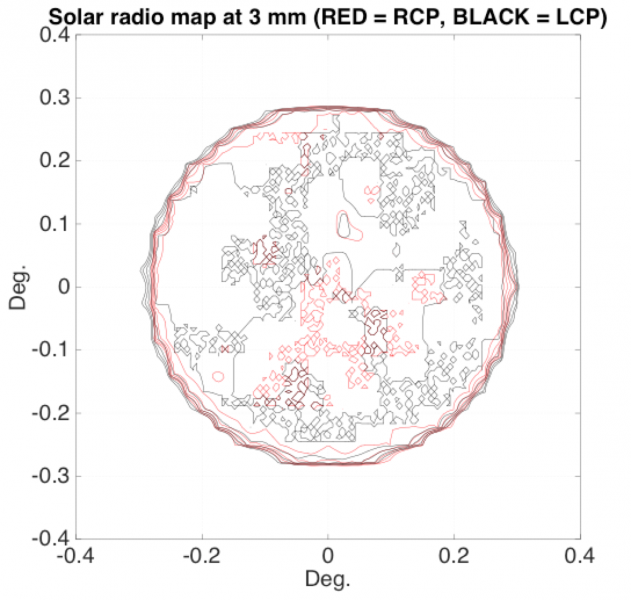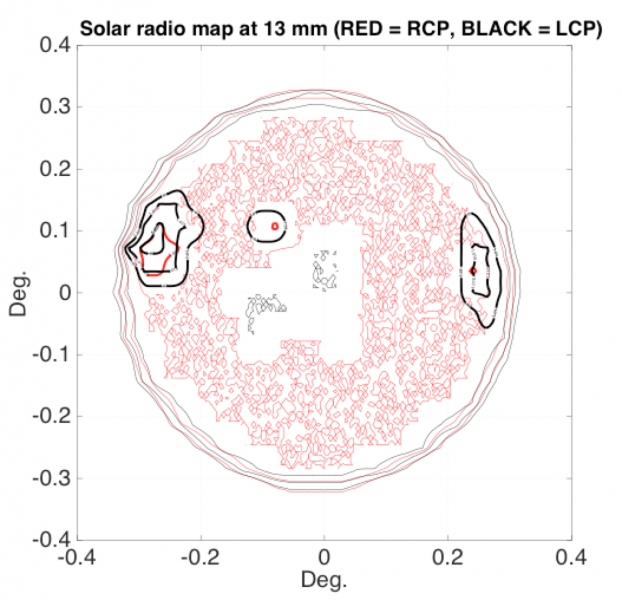Microwave solar polarization observations give us information about the magnetic field of the solar atmosphere. They are important for understanding the various solar activity phenomena and emission mechanisms related to them. Polarization properties of solar active regions have been studied previously mainly at lower radio frequencies.
Here we present solar radio polarization observations that were made at Aalto University Metsähovi Radio Observatory (MRO) in Finland with the 13.7-metre radio telescope, which is a radome-enclosed Cassegrain type antenna. The observations were made at 3 mm (86 GHz) and 13 mm (22 GHz) using the cryogenically cooled receivers that are mainly used for Very Long Baseline Interferometry (VLBI) observing campaigns. The receivers have dual-polarization properties with left hand (LCP) and right hand circular polarizations (RCP). The beam size of the radio telescope is 4.8 arc min at 13 mm and 1.1 arc min at 3 mm.
The properties of MRO’s solar observation capabilities are presented in Kallunki et al. (2018). Solar microwave observations at 3 mm (86 GHz) have also earlier been conducted at MRO, but not with this receiver and not with polarization observing capability.
Observations
3 mm (86 GHz) observations were made on April 4, 2019. The atmospheric conditions were very good during these observations. Two pairs of LPC+RCP solar polarization maps were made. There was an active region, NOAA 12737, on the Sun at the time of the observations, which is also visible on the 3 mm (86 GHz) solar radio map of Figure 1.
Observations were made close to the New Moon; the occurrence of the New Moon was April 5, 2019, and we also made one pair of lunar maps for calibration purposes. Using this information, we provisionally determined the quiet Sun level brightness temperature at 3 mm to be 6310 K. The method and procedure for the brightness temperature calibration is described in Kallunki & Tornikoski (2018) in more detail.

Figure 1 – Solar radio maps at 3 mm (86 GHz) observed on April 4, 2019. The red contour shows RCP and the black one LCP. The maximum intensity is around 102 % of the quiet Sun level.
The 13 mm observations were made on May 9, 2019. The atmospheric conditions were rather good during the observations; there were only some thin clouds in the sky. One pair of LCP+RCP polarization maps was made. Two active regions, NOAA 12740 and 12741, were visible on the Sun. In Figure 2, 13 mm solar radio maps are shown.

Figure 2 – Solar radio maps at 13 mm (22 GHz) observed on May 9, 2019. The red contour shows RCP and the black one LCP. The maximum intensity is around 102 % of the quiet Sun level.
Conclusions
This is the first time that 3 mm (86 GHz) and 13 mm (22 GHz) solar radio polarization observations were made with the same radio telescope. Our data confirm that our cryogenically cooled 3 mm and 13 mm VLBI receivers, along with our other instrumentation, produce reasonably good-quality solar radio maps and also that the polarization capabilities can be exploited to create solar polarization maps The dynamic range of our system is large enough to make both solar and lunar radio observations, which is beneficial for calibration purposes.
MRO is very well known for its very long-term and dense 8 mm (37 GHz) solar observation data sets. 3 and 13 mm solar radio observations will complement the data and add to the understanding of the structure and evolution of solar radio brightenings. The amount of solar radio polarization data is still very limited so far, and additional high radio frequency polarization observations through the various solar activity phases will be an important new asset for solar research.
Additional information
Based on the recent paper by Kallunki et al., “Solar polarization observations at 3 and 13 mm” Astronomische Nachrichten, Volume 341, Issue 1, pp. 118-124 (2020). DOI: 10.1002/asna.202013684
References
Kallunki, J., Tornikoski, M., Tammi, J., Kinnunen, E., Korhonen, K., Kesäläinen, S., & Arkko, O. 2018, Astron. Nachr., 339, 204
Kallunki, J., & Tornikoski, M. 2018, Sol. Phys., 293, 156
